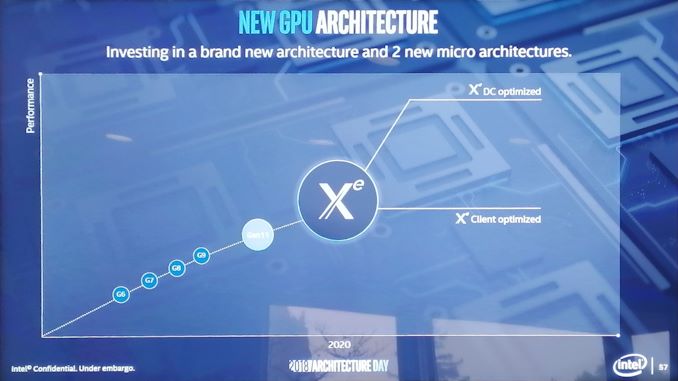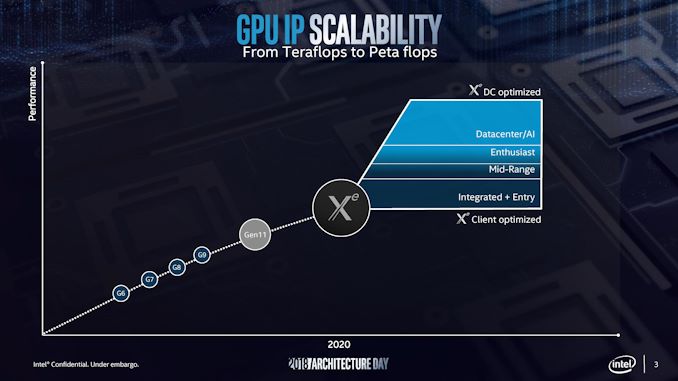Intel's Architecture Day 2018: The Future of Core, Intel GPUs, 10nm, and Hybrid x86
by Dr. Ian Cutress on December 12, 2018 9:00 AM EST- Posted in
- CPUs
- Memory
- Intel
- GPUs
- DRAM
- Architecture
- Microarchitecture
- Xe
Going Beyond Gen11: Announcing the XE Discrete Graphics Brand
Not content with merely talking about what 2019 will bring, we were given a glimpse into how Intel is going to approach its graphics business in 2020 as well. It was at this point that Raja announced the new product branding for Intel’s discrete graphics business:
Intel will use the Xe branding for its range of graphics that were unofficially called ‘Gen12’ in previous discussions. Xe will start from 2020 onwards, and cover the range from client graphics all the way to datacenter graphics solutions.
Intel actually divides this market up, showing that Xe also covers the future integrated graphics solutions as well. If this slide is anything to go by, it would appear that Intel wants Xe to go from entry to mid-range to enthusiast and up to AI, competing with the best the competition has to offer.
Intel stated that Xe will start on Intel’s 10nm technology and that it will fall under Intel’s single stack software philosophy, such that Intel wants software developers to be able to take advantage of CPU, GPU, FPGA, and AI, all with one set of APIs. This Xe design will feed the foundation of several generations of graphics, and shows that Intel is now ready to rally around a brand name moving forward.
There was some confusion with one of the slides, as it would appear that Intel might be using the new brand name to also refer to some of it's FPGA and AI solutions. We're going to see if we can get an answer on that in due course.












148 Comments
View All Comments
jjj - Wednesday, December 12, 2018 - link
And you acted like someone clueless that has put all his savings in Intel's stock based on brad, "Large revenue stream" LOL, you don't know anything about the product, the target market, about the packaging solution but you get all wet.Anyway, took a look at the slides and they do actually provide some relevant details that yuo seem to not notice. They say face-face, bump pitch at 36um and bump density at 828.mm2.
Spunjji - Thursday, December 13, 2018 - link
Your comments are unnecessarily aggressive, dripping with unwarranted confidence and really unpleasant to read. Please spend more time offline.jjj - Wednesday, December 12, 2018 - link
For the hell of it, I'll add this IMEC slide (different versions out there but this one was the first i could find)http://www.techdesignforums.com/practice/files/201...
iwod - Thursday, December 13, 2018 - link
ignore the trolls.Raqia - Wednesday, December 12, 2018 - link
That's a nice fan on their fanless SoC design. It seems like Intel is really playing catch up with their ultra mobile designs (with a power envelope that's likely still above phones) fabbed on a late 10nm design and only now doing things like heterogeneous cores and PoP memory that the AX and Snapdragons have been doing for a few years now.I wonder what portion of that block diagram's compute reside on the P1222 (which looks bigger die space wise on their diagram than the P1274 but may pack fewer transistors.) They mentioned IO but it wouldn't make too much performance sense for caches and coherency to segregate the Big/Little cores onto separate dies, so it likely contains the ISPs and memory controllers. Where the GPU is located is another interesting question and no LTE modem can be seen on the block diagram. This is also likely to have higher packaging cost and worse integration than the AX, Kirins, PXX's or Snapdragons.
A5 - Wednesday, December 12, 2018 - link
Dev boards have fans because they don't have a chassis to sink heat into. If it's like every other dev board I've used, it is probably a 8k RPM screamer, too.The_Assimilator - Wednesday, December 12, 2018 - link
Seems like you failed to read page 4: "These were development systems with these funky looking heatsinks and loud fans to ensure there was no thermal throttling."Raqia - Wednesday, December 12, 2018 - link
My comment was in reference to their new Atom lineup which are supposed to be fanless, not Sunny Cove which operates in a much higher power envelope. Surely they could use a larger passive cooling unit to demonstrate what's supposed to be a key feature of that product; my other point is that Intel's aiming for something later next year that seems much less advanced than what Apple, Huawei, Mediatek, and Qualcomm already have in production today.The_Assimilator - Thursday, December 13, 2018 - link
And, again, the Fovoros setup was a demo board in the open air, not a production chip inside a device designed around dissipating the heat it outputs.Spunjji - Thursday, December 13, 2018 - link
If that's what you took from that part of the presentation then I feel you missed the point. What Intel are doing in terms of chip layout is something none of the companies you mentioned are able to do yet, which is the fundamental point here - whether it results in a useful product is another matter entirely, but it's still fascinating and not same-same.To back up the other people who responded to you, again, the fan is irrelevant. It's a dev board.